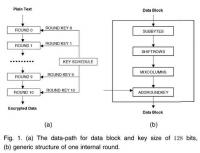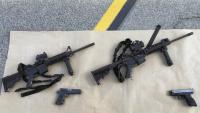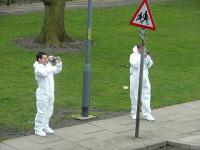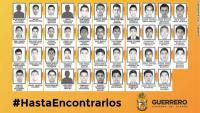-
Helping local law enforcement to share data
DHS Science and Technology Directorate’s (S&T) First Responders Group’s (FRG) Video Datacasting Project transmits encrypted live video and data over existing broadcast television signals to a targeted audience within public safety. Users can download data in the field, improving interoperability at minimal cost and effort in the furtherance of public safety.
-
-
Encryption prevents FBI from cracking San Bernardino attackers’ phone

U.S. law enforcement agencies have been unable to access a telephone used by the two Islamist attackers in the San Bernardino shooting, FBI director James Comey said Tuesday. Comey stressed that the post-Snowden end-to-end encryption some technology companies are now offering their customers make it impossible for law enforcement to learn more about terrorists and criminal networks, even after terrorist or criminal acts have been committed and even if a court has approved access to the information.
-
-
Doubts cast on Continuity IRA's claims of responsibility for Friday’s gang member shooting

Irish security sources have expressed their doubts over a claim by the Continuity IRA that it had carried out the attack on a boxing weigh-in at a Dublin hotel on Friday. Gang member David Byrne was shot dead and two others were injured in the carefully planned attack at the Regency hotel. The attack was carried out by six gunmen, one dressed as a woman.
-
-
Gun deaths in U.S. highest among high-income nations

New study finds that the United States, despite having only half the population of the other twenty-two high-income nations combined, accounted for 82 percent of all firearm deaths. In addition, the United State accounted for 90 percent of all women, 91 percent of children aged 0 to 14 years, and 92 percent of youth aged 15 to 24 years who are killed by firearms.
-
-
Oregon militia member killed, others arrested after standoff with police
Arizona rancher Robert “LaVoy” Finicum, 55, one of the armed antigovernment protesters occupying a remote federal facility in eastern Oregon, has been killed in a shootout with the FBI and state police. The group’s leader, Nevada rancher Ammon Bundy, and five other men were arrested. Those arrested were charged with conspiracy to impede officers of the United States from discharging their official duties through the use of force, intimidation, or threats.
-
-
Europol bolsters EU’s counterterrorism capabilities
Europe is currently facing the most significant terrorist threat in over ten years. The Paris attacks on 13 November 2015 indicate a shift toward a clear international dimension of Islamic State to carry out special forces-style attacks in the international environment. This and the growing number of foreign fighters are posing new challenges for EU Member States. Europol says that more attacks in the EU may happen in the future. Therefore, there is a great need within the European Union to strengthen our response to terror, to suspected terrorist networks and foreign fighters, and have an improved strategic understanding of threats.
-
-
Most Americans support smart guns: Survey

In 2014, the most recent year for which final data are available, 33,599 people died in the United States from gun violence. The majority were suicides (more than 21,000 deaths), and firearm homicides accounted for more than 11,000 deaths. Unintentional shootings, in which children are often the shooter or the victim, comprised more than 500 deaths that year. Survey finds that nearly 60 percent of Americans, if they buy a new handgun, are willing to purchase a smart or childproof gun — a weapon that is only operable in the hands of an authorized user.
-
-
How dangerous people get their guns
The San Bernardino massacre is unique in several respects, but it does bring into focus an important issue with broad relevance: how do dangerous people obtain guns, and what should the police and courts be doing to make those transactions more difficult? Criminal assaults with guns kill thirty Americans every day, and injure another 170. The guns carried and misused by youths, gang members, and active criminals are more likely than not obtained by transactions that violate federal or state law. Unlike in the case of Enrique Marquez, a friend and neighbor of the terrorist couple who purchased two military-style rifles for them, it is rare for the people who provide these guns to the eventual shooters to face any legal consequences. Currently it is rare for those who provide guns to offenders to face any legal consequences, and changing that situation will require additional resources directed to a proactive enforcement directed at penetrating the social networks of gun offenders.
-
-
Canada avoids sex attacks by accepting refugee families over single men
Canada’s immigration minister John McCallum said Canada will not suffer from Cologne-style sex attacks because the country “carefully selects” the Syrian refugees it takes in. McCallum said that because Canada has welcomed Syrian refugees “with open hearts and love,” Canadians will not be affected by their resettlement as Germany has been. “Most of them are not single men. Most of them are family members. Whereas Germany accepts everybody that comes to its borders,” McCallum said.
-
-
FBI antiterrorism unit arrests white supremacist for contract killing plot
A leading member of a white supremacist gang in Louisiana was arrested by FBI agents over a murder-for-hire scheme. Jeffery Howard of Mississippi, a known member of the Aryan Brotherhood, was arrested Thursday. Federal authorities say he had agreed to execute a black drug dealer for $5,000.
-
-
Rate of violent crime in England and Wales rising

A new method of analyzing crime statistics finds that violent crime in England and Wales is increasing, not decreasing. These findings contradict the official view that violent crime in England and Wales is continuing to fall.
-
-
What makes a “smart gun” smart?

Throughout the 20-year-long discussion of “smart guns,” the topic has been a lightning rod for debate between pro- and anti-gun lobbies. But too often, there isn’t substantive knowledge of the underlying technologies, their appropriate use and their design limitations. Personalized weapons technology can make a contribution to reducing death and injury from accidental or unauthorized weapons use. It is not a panacea, but it can be an option for gun buyers to ensure their weapons never fall into the wrong hands. Smart guns are not science fiction and could be a commercial reality much sooner than later.
-
-
ISIS follower shoots Philadelphia police officer
A man who shot a Philadelphia policeman while he was sitting in his squad car and wounded him, was inspired by ISIS. Edward Archer used a stolen gun to fire eleven shots at Jesse Hartnett in – but Hartman, despite being wounded, was able to get out of the car and return fire, hitting the gunman three times.
-
-
Mexico’s homicide rate has led to decrease in men’s life expectancy

Mexico’s staggering homicide rate has taken a toll on the mortality rate for men — and it could be even worse than the statistics indicate. The homicide rate more than doubled from 9.5 per 100,000 deaths in 2005 to 22 per 100,000 by 2010. As a result, average life expectancy among Mexican men ages 15 through 50 fell from 33.8 years to 33.5 years between 2005 through 2010.
-
-
New York City settles Muslim surveillance lawsuits

The NYPD has been agreed not to conduct surveillance based on religion, race, and ethnicity after charges that it had illegally monitoring Muslims in New York City. The city has agreed to settle two civil rights lawsuits for illegally monitoring its Muslim community following the September 11 attacks. As part of the settlement, in which the city does not admit to any wrongdoings, the city will appoint a civilian to monitor the NYPD’s counterterrorism unit.
-
More headlines
The long view
How Male Grievance Fuels Radicalization and Extremist Violence
Social extremism is evolving in reach and form. While traditional racial supremacy ideologies remain, contemporary movements are now often fueled by something more personal and emotionally resonant: male grievance.
